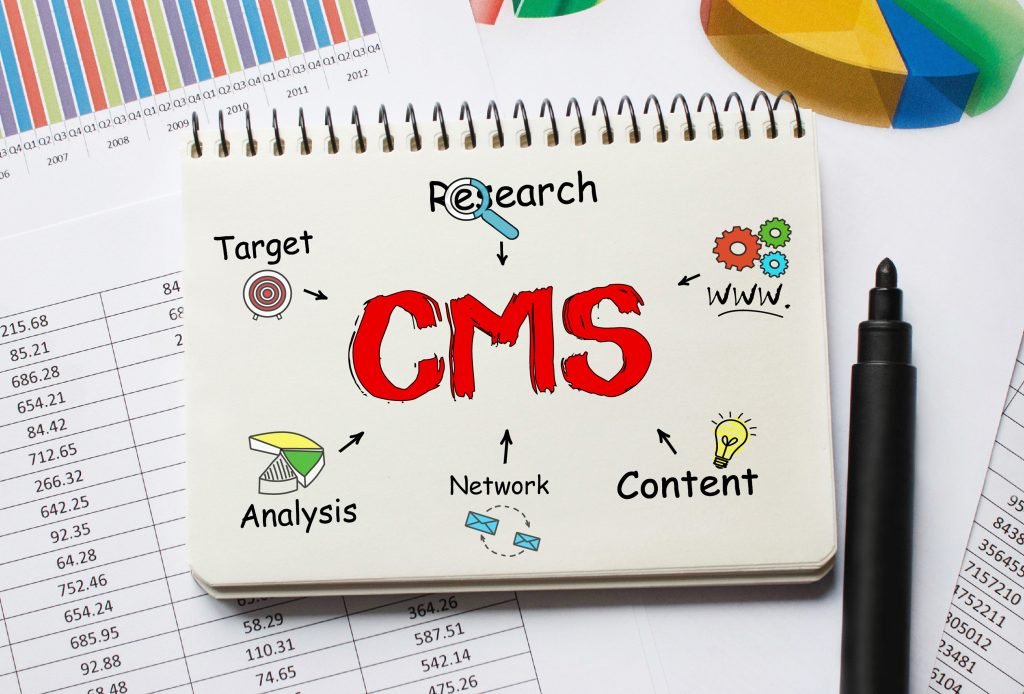In the rapidly evolving world of web design, creating and managing websites efficiently has become a necessity for businesses and individuals alike. Whether you’re running a personal blog, a corporate website, or an online store, a Content Management Systems (CMS) is a powerful tool that makes it easy to build, update, and maintain your web presence without needing extensive technical skills.
This article will explore what a CMS is, the different types available, and how it’s used in web design, with insights into choosing the right platform for your needs.
What is a Content Management Systems (CMS)?
A Content Management Systems (CMS) is a software application that allows users to create, edit, organize, and publish digital content. Essentially, it’s a platform where users can manage the front-end and back-end of a website with ease, without having to write code. Content Management Systems platforms have transformed web design by empowering users to build professional-looking websites, even if they have minimal technical knowledge.
1. Key Features of a Content Management Systems
A CMS typically includes features like:
- Content Creation and Editing Tools: Easy-to-use text editors and media uploading capabilities.
- Templates and Themes: Pre-designed layouts and styles to simplify the design process.
- SEO Tools: Built-in tools to help optimize content for search engines.
- User Management: Allows multiple contributors to work on a website with specific permissions.
- Media Library: Store and manage images, videos, and other multimedia files.
- Analytics and Reporting: Track website performance and gain insights into user behavior.
These features make it easier for businesses and individuals to control their website’s appearance, functionality, and content.
2. How Does a Website CMS Work?
A CMS works as the “engine” of a website, managing the data and functionality needed to display content on the front end (the part users see) and handle data on the back end (where data is stored and managed). When you use a website CMS, you’re essentially managing two main components:
- Content Management Application (CMA): The front-end part where users create and manage content.
- Content Delivery Application (CDA): The back-end part that compiles data and presents it to users as a fully functional website.
Using a CMS streamlines the workflow of web design, allowing you to design and publish new content with minimal delay, which is essential for keeping audiences engaged and up-to-date.

3. Types of CMS Platforms
There are several types of CMS platforms available, each designed for different needs and uses:
Open Source CMS
An Open Source CMS is typically free to use and allows users to modify its source code. Popular open-source platforms include WordPress, Joomla, and Drupal. Open-source CMS platforms are highly flexible and supported by large communities of developers, providing a wide range of plugins, themes, and customization options. They’re ideal for blogs, small businesses, and individuals looking for cost-effective solutions.
Enterprise CMS
Enterprise CMS platforms are robust solutions designed for large organizations and complex websites. They offer advanced features like content personalization, scalability, and multi-channel publishing. Examples include Adobe Experience Manager and Sitecore. An enterprise CMS typically requires greater resources to implement but provides powerful tools for managing large volumes of content across different teams and departments.
Ecommerce CMS
An Ecommerce CMS is specifically designed for online stores. Platforms like Shopify, Magento, and WooCommerce (an e-commerce plugin for WordPress) offer specialized features for managing product catalogs, inventory, payments, and shipping. An ecommerce CMS makes it easy for businesses to build, customize, and manage an online store, even if they have no coding experience.
4. How CMS Transforms Web Design
A CMS plays a crucial role in modern web design by simplifying the process of creating and managing websites. Here are some ways a CMS impacts web design:
- Time Efficiency: CMS platforms speed up the design and development process with pre-designed templates and customizable themes.
- Content Focus: By separating content from code, CMS allows web designers to focus on creating high-quality content without worrying about technical details.
- Responsive Design: Many CMS platforms offer responsive templates that ensure websites look great on any device, be it desktop, tablet, or mobile.
- User Collaboration: A CMS allows multiple users to work on the same website, improving collaboration and workflow, especially for larger teams.
In short, CMS platforms streamline the entire web design process, making it easier to launch and maintain professional websites.
5. Popular Examples of CMS Platforms
Different CMS platforms serve different purposes. Here are a few popular options:
- WordPress: Known for its user-friendliness, WordPress is one of the most popular CMS platforms for blogs, business websites, and even ecommerce sites with WooCommerce.
- Shopify: A specialized ecommerce CMS that is ideal for online stores, offering an easy-to-use interface and robust ecommerce features.
- Joomla: A versatile CMS with more complex options, suitable for websites requiring more flexibility and control.
- Magento: A powerful ecommerce CMS designed for larger businesses with complex ecommerce needs.
- Drupal: Known for its high level of customization and scalability, making it a preferred choice for developers and larger websites.
Each CMS has unique advantages, and choosing the right one depends on factors such as budget, technical expertise, and specific website requirements.

6. Choosing the Right CMS for Your Needs
Selecting the right CMS is a crucial decision in web design. Consider the following factors:
- Purpose of the Website: For a blog, WordPress might be the best choice. For an ecommerce website, Shopify or Magento could be more suitable.
- Budget: Some CMS platforms are free (open source), while others require subscriptions or licenses (such as many enterprise CMS solutions).
- Customization Needs: If you need heavy customization, open-source CMS options like Drupal may be ideal.
- User-Friendliness: Platforms like WordPress and Shopify are user-friendly, ideal for those with minimal technical experience.
7. Benefits of Using a CMS in Web Design
Using a CMS offers several advantages:
- Cost-Effective: Open-source CMS platforms are usually free, making web design more affordable.
- Flexible: A CMS lets you update your website without needing to rely on a developer.
- SEO-Friendly: Many CMS platforms come with built-in SEO tools or support SEO plugins, making it easier to optimize your website for search engines.
- Security: Leading CMS platforms regularly release updates to enhance security and protect your website from cyber threats.
- Scalability: With the right CMS, your website can grow alongside your business, accommodating higher traffic and new content effortlessly.
8. Common Uses of a CMS in Web Design
CMS platforms are versatile and can be used for various types of websites:
- Blogs: CMS platforms simplify posting and managing content, making them ideal for bloggers.
- Business Websites: Companies use CMS to easily update content and manage services, products, and contact information.
- Online Stores: Ecommerce CMS platforms support features like product listings, shopping carts, and secure payment processing.
- Educational Websites: Educational institutions use CMS to manage and organize course materials, announcements, and resources for students.
- Portfolios: Creative professionals can use a CMS to create attractive, easily updated portfolios to showcase their work.
9. The Future of CMS in Web Design
As web design trends evolve, CMS platforms are likely to keep up with new features, such as:
- Enhanced Mobile Optimization: With mobile usage continuing to rise, CMS platforms will focus even more on creating mobile-friendly websites.
- Improved Security Features: Security will remain a priority as CMS platforms aim to protect websites from cyber threats.
- AI-Powered Customization: AI will help CMS users create more personalized and dynamic websites, adjusting content based on user behavior.
These advancements are set to make CMS platforms an even more integral part of web design.

Conclusion
A Content Management Systems is a powerful tool that simplifies web design, making it accessible to everyone from novice bloggers to large corporations. By choosing the right CMS, you can build a website that’s visually appealing, user-friendly, and easy to maintain. For professional guidance in CMS implementation and management, Optominds in Sydney stands out as a top service provider, offering expert support to make your CMS experience seamless.
Looking to create or revamp your website with a reliable CMS? Contact Optominds, Sydney’s leading CMS service provider, to start building your dream website today!
FAQs
1. What is the main advantage of using a CMS for website management?
A CMS simplifies content creation and updates, enabling non-technical users to manage a website easily and efficiently.
2. Are CMS platforms secure for building a website?
Yes, most CMS platforms have security features and regular updates to help protect your website. However, it’s essential to keep plugins and the CMS core up-to-date for maximum security.
3. Which CMS is best for a small business?
For small businesses, WordPress and Shopify are popular choices due to their ease of use, customization options, and extensive plugins.
4. Can I switch CMS platforms if my needs change?
Yes, it’s possible to switch CMS platforms, though it may require data migration. Consulting with a professional CMS service provider can make this process easier.
5. Is there a CMS specifically for ecommerce websites?
Yes, eCommerce-specific CMS platforms like Shopify, Magento, and WooCommerce (WordPress plugin) are tailored to meet the needs of online stores, offering tools for product listings, shopping carts, and secure payments.

